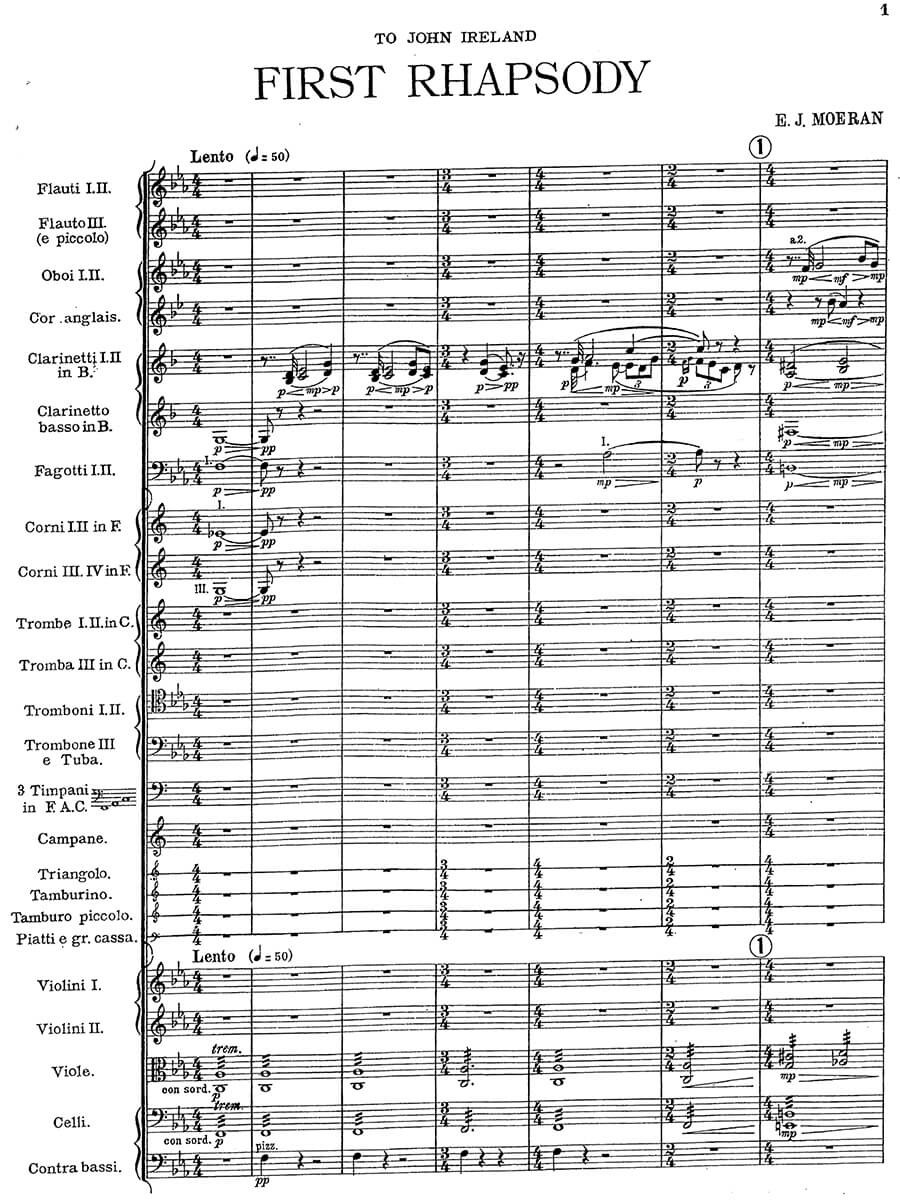First Rhapsody for orchestra
Moeran, Ernest John
19,00 €
Preface
Ernest John Moeran – First Rhapsody for Orchestra
(b. 31 December 1894, Heston, Middx. – d. 1 December 1950, Kenmare, Co. Kerry, Ireland)
Preface
Ernest John Smeed Moeran, better known as E. J. Moeran, and to his friends as ‘Jack’, came from an Irish-born father and a Norfolk-born mother. Although his father, Rev. J. W. W. Moeran, was of Dutch descent and barely lived in Ireland more than a year after his birth, his son was drawn to the land, both for recreation and inspiration. Likewise, his mother’s native Norfolk nurtured his love of the countryside and its music.
After attending Uppingham School where the music master was Robert Stearndale Bennett (grandson of Mendelssohn’s friend William), who was very influential, Moeran gained a scholarship to the Royal College of Music. He entered it in 1913 but his studies were interrupted by war in which he served in the 6th (Cyclist) Battalion of the Norfolk Regiment as a motor-cycle dispatch rider. On 3 May 1917 at Bullecourt he was badly injured by shrapnel in the head, some of which could never be removed. For the rest of his life he had a metal plate in his skull, and suffered pain and mood swings, often deep depression, and a descent into alcoholism.
He re-entered the Royal College in 1920 and became a pupil of John Ireland. He became part of a circle that included Ireland, Philip Heseltine (Peter Warlock), Harriet Cohen, and Arnold Bax. In the 1930s and he wrote a symphony that is regarded as one of the very finest British symphonies. He also wrote concertos for violin and cello, several chamber works and songs.
He died unexpectedly whilst on holiday in Ireland, seemingly from a brain haemorrhage.
On his return to the Royal College in 1920 he became a pupil of John Ireland, who set him to work at seemingly endless exercises in counterpoint. Moeran later wrote, “I have always been so lazy that it would have been nearly impossible to induce me to go to the trouble of working a single counterpoint exercise, had I not been encouraged by Ireland to believe in some very definite value in doing so. I am glad of this today, for I have come to realise that only by this means can a subconscious sense of harmony, melody and rhythm be acquired”. Immediate consequences of this were his orchestral works In The Mountain Country (MPH score no. 4421) and Rhapsodies 1 & 2.
The first of the two Rhapsodies owes something to Vaughan Williams’s Norfolk Rhapsodies (1906, 1912 and 1920) – Moeran was from Norfolk – but unlike them it is not based on folk tunes. Its most immediate model may well have been George Butterworth’s Rhapsody: ‘A Shropshire Lad’ of 1913 (MPH score 622). Indeed, Moeran seems to have had an affinity with Butterworth, even though he never met him’ arguing later that artists should be exempted from war service. Moeran’s Rhapsody is in F major and begins with clarinet-led woodwinds over sustained tremolando strings, in a rhythmically-loose polyphony based on a three-note motif that returns many times. A brash march rhythm appears, and the whole works becomes a series of alternations between the major-key march and the minor-key musings. The Rhapsody ends shrouded in mists.
The first performance was in a Patrons’ Fund Concert at the Royal College of Music in 1922, followed by another at Bournemouth under Dan Godfrey, and Henry Wood included it in the 1924 Promenade Concerts.
Phillip Brookes, 2021
Aufführungsmaterial ist von Boosey & Hawkes, Berlin, zu beziehen. Nachdruck eines Exemplars aus der Sammlung Phillip Brookes, Roxas City.
Score Data
| Special Edition | The Phillip Brookes Collection |
|---|---|
| Genre | Orchestra |
| Size | 210 x 297 mm |
| Printing | Reprint |
| Pages | 48 |
